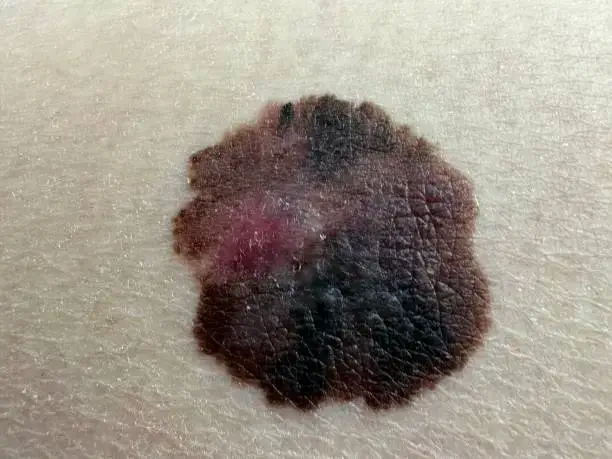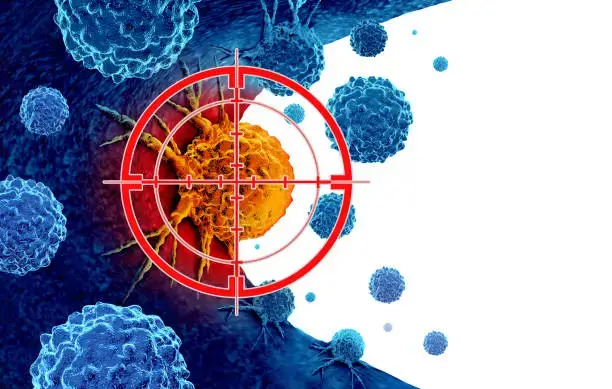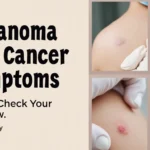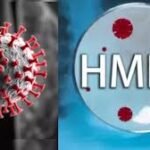We envision a world where everyone has the tools and knowledge to live a balanced, healthy, and fulfilling life. By providing reliable resources, personalized programs, and community support, we aim to be a beacon of hope for those on their health journey.
Table of Contents
Introduction to Melanoma

melanoma skin cancer symptoms
Melanoma is a serious form of skin cancer that develops from melanocytes, the pigment-producing cells responsible for giving color to our skin. Skin Cancer Symptoms; These cells can become malignant due to various factors, including excessive exposure to ultraviolet (UV) radiation from the sun or tanning beds. As a result of this mutation, the ability of the skin to regulate growth and cell division is hampered, potentially leading to the formation of tumors. Early detection of melanoma is crucial as it significantly increases the chances of successful treatment and recovery.
In recent years, the incidence of melanoma has been rising at an alarming rate worldwide. According to statistics, melanoma represents a small percentage of skin cancer cases, yet it accounts for the vast majority of skin cancer-related deaths. This underscores the importance of understanding the symptoms associated with this disease. Recognizing the early signs of melanoma can empower individuals to seek prompt medical attention, thus enhancing their prognosis and treatment options.
Awareness of the symptoms associated with melanoma is essential for effective early detection. Common signs may include changes in existing moles, the development of new pigmented lesions, or any irregularities in color, size, or shape. Regular skin checks, either performed independently or by a healthcare professional, play a fundamental role in identifying potential malignancies at an earlier stage. Education regarding melanoma, coupled with proactive skin health measures, can ultimately contribute to a reduction in its occurrence and mortality rates. Understanding the nature of melanoma and the importance of vigilance is a vital step in combating this life-threatening illness.
Common Symptoms of Melanoma
Melanoma, a serious form of skin cancer, often presents with specific symptoms that individuals should monitor during self-examinations. Recognizing these symptoms early can be crucial for effective treatment. One of the primary indicators is the alteration of existing moles or skin lesions. The ABCDE rule serves as a helpful guide in identifying potential melanomas.
The first component, Asymmetry, refers to moles or lesions that are not evenly shaped. If one half of a mole does not match the other in shape or color, this could be a warning sign. The second factor, Borders, concerns the edges of the mole. Normal moles typically have smooth, even borders, whereas melanoma may exhibit irregular, notched, or scalloped edges.
Color variation is the third symptom to monitor. Moles should ideally be uniform in color, whether they are brown, black, or tan. However, melanoma may display multiple colors, including shades of tan, brown, black, red, white, or blue. This variation indicates the presence of abnormal cells and merits closer inspection.
The fourth indicator is Diameter. A melanoma typically exceeds 6mm in diameter; however, they can be smaller. Regularly examining moles for growth may help in early detection. Finally, Evolving symptoms emphasize the importance of watching for changes in size, shape, color, or any other characteristics of a mole. A mole that appears to be changing over time should be evaluated by a healthcare professional.
By keeping an eye out for these common symptoms—specifically asymmetry, irregular borders, multiple colors, large diameter, and evolving changes—individuals can take proactive measures towards their skin health. Regular skin checks and consultations with healthcare providers are essential in maintaining well-being.
ABCDE Rule: A Guide to Identifying Melanoma

The ABCDE rule is an essential guideline developed for the early detection of melanoma, a serious form of skin cancer. This mnemonic serves as an effective method for individuals to evaluate their moles and skin lesions. Each letter represents a key characteristic to look for when assessing whether a mole may be potentially problematic.
A for Asymmetry: When evaluating a mole, one should observe its shape. Asymmetrical moles, where one half does not mirror the other, may indicate malignancy. For example, if an individual draws a line through the center of the mole and the two halves do not match in size or shape, this irregularity warrants professional examination.
B for Border: The borders of benign moles are generally smooth and even. In contrast, a mole with irregular, jagged, or blurred edges may be cause for concern. Such border irregularities can signify the onset of melanoma, and it is advisable to promptly consult a healthcare provider if these features are observed.
C for Color: A mole that displays a variety of colors, including shades of brown, black, tan, red, white, or blue, raises suspicion. A consistent color throughout is more typical of non-cancerous growths. Therefore, the presence of multiple colors can be a crucial indicator in determining whether a mole should be investigated further.
D for Diameter: Typically, moles that are greater than 6 millimeters in diameter (approximately the size of a pencil eraser) are more likely to be concerning. However, smaller moles can also be problematic; size alone should not be the sole determining factor.
E for Evolution: Finally, any changes in size, shape, color, or elevation of a mole, or any new symptoms such as bleeding, itching, or crusting, indicate a need for medical evaluation. Monitoring existing moles and noting any alterations over time is crucial in identifying potential melanoma.
By understanding the ABCDE rule, individuals can take proactive steps in monitoring their skin health. Regular skin checks that incorporate these guidelines enhance awareness and can lead to earlier detection of melanoma, improving treatment outcomes.
Less Common Symptoms of Melanoma
While many are aware of the common symptoms associated with melanoma skin cancer, such as changes in the appearance of moles, there are also less common signs that should not be ignored. Recognizing these additional symptoms is crucial, as they may indicate the presence of melanoma even when the more well-known symptoms are absent. Among these less recognized symptoms is the formation of non-healing sores, which may occur on the skin. These sores can manifest as ulcers or open wounds that do not respond to typical healing methods, potentially signaling an underlying issue.
Another symptom to be vigilant about is the appearance of new moles on the skin. It is normal to develop moles throughout one’s life; however, the emergence of new moles, especially in individuals over the age of 30, warrants further examination. Such new growths may bear resemblance to existing moles or exhibit features that make them suspicious, thereby requiring comprehensive evaluation by a dermatologist. Furthermore, existing moles may also undergo changes that merit attention. Changes in color, shape, or size can indicate an evolving condition that could potentially be melanoma. This phenomenon can manifest as irregular borders or asymmetrical shapes, distinguishing these moles from benign growths.
Itchiness of the skin can also serve as a less common but noteworthy symptom of melanoma. Persistent or unusual itchiness, especially in areas with moles, may be a sign of changes occurring in the skin’s underlying structures. Such itchiness should not be brushed aside, as it may be indicative of melanoma’s progression. Overall, understanding these less common symptoms is vital for early detection and intervention. Early intervention significantly heightens the chances of successful treatment, underscoring the importance of maintaining vigilance for any signs that could suggest melanoma’s development.
Risk Factors for Developing Melanoma

Melanoma skin cancer is influenced by a variety of risk factors that can significantly increase an individual’s likelihood of developing this serious condition. Understanding these factors is essential for prevention and early detection. One of the primary risk factors is genetic predisposition. Individuals with a family history of melanoma or certain genetic mutations, such as those affecting the CDKN2A gene, are more susceptible to developing this type of skin cancer. Genetic predispositions can be inherited, indicating that family members of melanoma patients should be vigilant about monitoring their skin health.
Skin type also plays a critical role in the risk of developing melanoma. Fair-skinned individuals, particularly those with blond or red hair and blue or green eyes, have a higher risk compared to those with darker skin tones. This is largely due to the lower levels of melanin in lighter skin, which provides less natural protection from harmful UV radiation. Beyond skin type, individuals with many moles or atypical moles (dysplastic nevi) are at an increased risk; such landmarks can indicate a tendency towards abnormal skin cell growth.
Sun exposure, both from natural sunlight and artificial sources like tanning beds, is a significant environmental factor contributing to melanoma risk. Those who experience excessive or unprotected sun exposure, especially during childhood or adolescence, are at particular risk due to the likelihood of sunburns, which can damage the skin’s cellular structure. Moreover, individuals with existing skin conditions, such as actinic keratosis or previous instances of skin cancer, need to be particularly cautious, as these conditions can heighten the risk of developing melanoma. Understanding these various risk factors is critical for individuals to take appropriate preventive measures and seek timely medical advice when necessary.
Diagnosing Melanoma: What to Expect
Diagnosing melanoma, a serious form of skin cancer, is a crucial step in ensuring effective treatment. The process typically begins with a thorough skin examination performed by a dermatologist. During this examination, the dermatologist inspects the skin for any unusual moles or growths that may indicate melanoma. Using a dermatoscope, a specialized tool that magnifies the skin’s surface, dermatologists can gain a clearer view of pigmented lesions, helping to discern between benign and malignant growths. This examination is vital, as early detection significantly increases survival rates.
In cases where a mole is suspected to be cancerous, a biopsy is often necessary. A biopsy involves removing a small sample of skin for pathological analysis. There are different types of biopsies that dermatologists may perform. A shave biopsy removes the outer layers of skin, while an excisional biopsy involves removing the entire mole along with some surrounding tissue. In some cases, a punch biopsy may be utilized, which removes a circular piece of skin. The choice of biopsy method depends on various factors, including the location and characteristics of the lesion.
Once the biopsy is conducted, the obtained tissue sample is examined under a microscope by a pathologist. The results of this examination will determine whether the lesion is benign or malignant and inform the stage of the melanoma if it is diagnosed. Staging is essential as it guides treatment options, which may include surgery, immunotherapy, or targeted therapies. Understanding the diagnosis process helps patients navigate their journey with greater awareness and equips them to make informed decisions about their health.
Preventive Measures and Early Detection

Melanoma skin cancer, a serious form of skin cancer, underscores the importance of preventive measures and early detection in improving treatment outcomes. Regular skin checks are essential not only for individuals with a history of skin cancer but also for the general population, as early identification of suspicious moles or skin changes can lead to timely intervention. Conducting self-examinations can be effectively integrated into one’s routine; it is advisable to perform these checks monthly. Individuals should examine their skin in good lighting, using mirrors to observe hard-to-see areas, such as the back or scalp.
The use of sunscreen plays a critical role in melanoma prevention. Dermatologists recommend broad-spectrum sunscreen with an SPF of 30 or higher, which protects against both UVA and UVB rays. It is crucial to apply sunscreen generously and reapply every two hours when outdoors, especially after swimming or sweating. In addition to sunscreen, wearing protective clothing, such as long-sleeved shirts, wide-brimmed hats, and UV-blocking sunglasses, can significantly reduce skin exposure to harmful ultraviolet (UV) rays. Opting for clothing with UPF (Ultraviolet Protection Factor) ratings can further enhance protection against UV exposure.
Furthermore, individuals should remain aware of their skin’s appearance and any changes that may occur over time. melanoma symptoms; The ABCDE rule is an effective guide for assessing moles: Asymmetry, Borders, Color, Diameter, and Evolving are critical characteristics to monitor. melanoma symptoms; If any moles or lesions exhibit these warning signs, it is advised to seek professional evaluation promptly. melanoma symptoms; By remaining vigilant and practicing these preventive measures, individuals can significantly enhance their chances of early detection and successful treatment of melanoma skin cancer.
When to Seek Medical Attention
Recognizing the signs of melanoma skin cancer is crucial for early detection and effective treatment. melanoma symptoms; While many skin changes may not be significant, certain indicators should prompt immediate consultation with a healthcare professional. melanoma symptoms; Individuals should take notice of any new or changing moles, particularly those that exhibit irregularities in color, shape, or size. melanoma symptoms; A mole that has changed rapidly, or one that appears different from others, often referred to as the “ugly duckling” sign, can be a red flag for potential melanoma.
Moreover, pay attention to the texture of skin lesions. melanoma symptoms; If a mole becomes crusty, scaly, or exhibits bleeding, it is essential to seek medical evaluation. melanoma symptoms; Symptoms such as itchiness or pain associated with a mole can also be concerning. melanoma symptoms; The ABCDE rule, which stands for Asymmetry, Border irregularity, Color changes, Diameter greater than 6mm, and Evolving shape or color, serves as a helpful guideline when assessing moles for warning signs of melanoma.
Another critical factor is the presence of multiple symptoms. melanoma symptoms; If a person notices several concerning moles on their body, particularly if there are atypical moles that fall outside normal characteristics, this accumulation warrants professional advice. melanoma symptoms; Additionally, individuals with a family history of melanoma or those with numerous nevi (moles) should regularly monitor their skin and seek evaluations from a dermatologist.
Finally, individuals should not hesitate to contact their healthcare provider if they have any doubts or concerns regarding their skin health. melanoma symptoms; Early recognition of potential symptoms can be life-saving, and taking proactive measures is an essential part of maintaining overall well-being. melanoma symptoms; Regular skin checks and awareness can significantly aid in the early diagnosis of melanoma skin cancer.
Conclusion: The Importance of Awareness

Awareness of melanoma skin cancer symptoms plays a crucial role in early detection and effective treatment. melanoma symptoms; Throughout this blog post, we have examined the various signs that may indicate the presence of melanoma, such as changes in existing moles, the emergence of new growths, and atypical skin changes. melanoma symptoms; Recognizing these symptoms early can significantly improve patient outcomes, making vigilance essential for all individuals, regardless of their skin type or personal history.
In our exploration, we highlighted how the ABCDE guideline—Asymmetry, Border, Color, Diameter, and Evolving—serves as a valuable tool for assessing moles or spots on the skin. melanoma symptoms; Each of these factors can provide insight into potential risks associated with melanoma. melanoma symptoms; Additionally, we noted the importance of routine skin examinations, both self-conducted and by healthcare professionals, to ensure that any irregularities are monitored and addressed promptly.
Moreover, sharing knowledge about melanoma symptoms among family and friends is vital in fostering a community that prioritizes early detection. melanoma symptoms; Many people remain unaware of the seriousness of skin cancer and its indicators, which underscores the relevance of education and awareness campaigns. melanoma symptoms; Encouraging your social circles to be proactive regarding their skin health can create a ripple effect, increasing the likelihood of early identification of melanoma.
In closing, maintaining a high level of awareness about melanoma skin cancer symptoms is paramount. melanoma symptoms; Each individual’s vigilance contributes not only to their own health but also to the well-being of those around them. melanoma symptoms; Being informed empowers everyone to participate in their health management actively. melanoma symptoms; By equipping ourselves with the knowledge to recognize potential warning signs, we not only promote awareness but may ultimately save lives.
Did You Try this tips ?
There are no reviews yet. Be the first one to write one.
blood work brain health climate health diabetes treatments digestive health disease management disease mapping exercise plan fitness tips hair care hair growth hair treatment headache treatment health care health expenses health foods health insurance health secrets health tips healthy alternatives healthy habits healthy recipes heart health home workouts immune boost immune foods keto delivery lifestyle diseases medicine innovation mental health morning exercise natural remedies nutritional advice raw nutrition skin cancer skin care skin health sleep exercise sleep technology telemedicine services telemedicine solutions unhealthy habits viral threats walking benefits weight loss
melanoma skin cancer symptoms: How to Check1 Your Skin now
Melanoma is a serious form of skin cancer that develops from melanocytes, the pigment-producing cells responsible for giving color to our skin. Skin Cancer Symptoms; These cells can become malignant due to various factors, including excessive exposure to ultraviolet (UV) radiation from the sun or tanning beds. As a result of this mutation, the ability of the skin to regulate growth and cell division is hampered, potentially leading to the formation of tumors. Early detection of melanoma is crucial as it significantly increases the chances of successful treatment and recovery.





